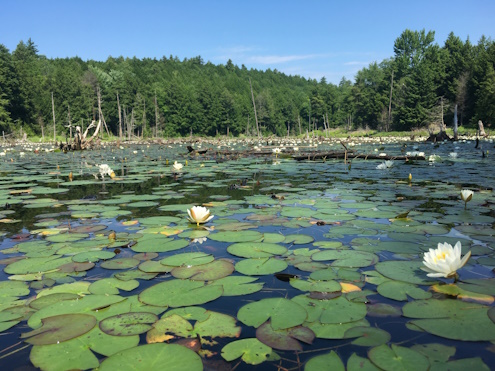
This pond in the Town of Bolton will soon be permanently protected by the LGLC with support from the recently announced grants from NYS DEC.
The Lake George Land Conservancy (LGLC) is pleased to announce that it has been awarded grants totaling $4.15 million for land acquisition for source water protection from the Water Quality Improvement Project (WQIP) grant program administered by the New York State Department of Environmental Conservation (DEC).
The LGLC will use $3.5 million of the grant funds to permanently protect over 700 acres in the Indian Brook sub-watershed region of the Town of Bolton. Maintaining forested buffers around the streams and wetlands of this area will prevent erosion, filter sediment and pollutants from stormwater, and aid with flood resiliency.
The remaining grant funds will be directed toward the purchase of a 73-acre forested property in the Town of Lake George. This property contains 1,545 feet of streams with a healthy vegetated buffer that will further safeguard the water quality of Lake George, a drinking water source, and the surrounding watershed.
LGLC Executive Director Michael Horn said, “We are grateful to New York State and Governor Hochul for supporting our work to protect Lake George by protecting the land around it. By keeping our forests healthy and whole, we’re allowing the land to do what it does best – filter water, reduce pollution, and prevent stormwater issues downstream.
“With these grants we will be able to advance a number of projects over the next few years, but there is still much work to be done, including raising the more than $1 million in required matching funds.”
Land conservation is an efficient, cost-effective tool for protecting water quality. By focusing efforts on the most sensitive wetlands, streams, slopes, and shoreline, it can prevent costly issues that may arise from poorly designed development, non-porous infrastructure, and severe weather events.
These grants are part of a $166 million total announcement by NYS DEC for 187 projects statewide that will help protect drinking water, update aging water infrastructure, combat contributors to harmful algal blooms, and improve aquatic habitat.
